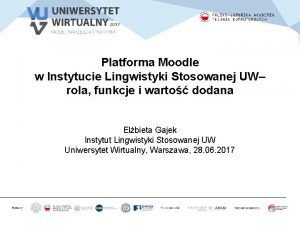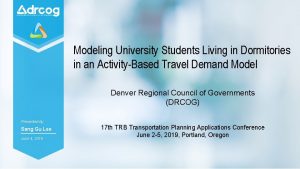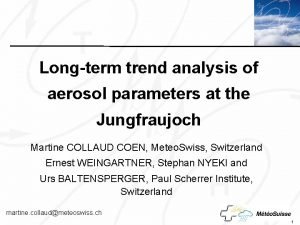Click to edit Master title style ILA Followership













- Slides: 13

Click to edit Master title style ILA Followership Symposium Rachael Morris Click to edit Master subtitle style Thursday 30 th October 2014 rachael. l. morris@northumbria. ac. uk 26/10/2021 14/01/16 1

Constructions of following from a relational perspective: a follower-focused study Outline: • • • Research focus Research design Research context Illustrative data extracts Future considerations Questions and discussion

Research Focus • Imbalance- between the followership and leadership fields • Exploring processes of following- what does this mean, how is this experienced, how is this different to assumptions in the literature (as opposed to essentialist tendency, (Uhl-Bien et al, 2014)) • Exploring the lived experiences- of individuals when doing following (Mc. Namee & Hosking, 2012) • Adopting qualitative and visual methods- to gain rich insights into this underexplored area, constructions and co-construction • Adopting an empirical approach- to progress understandings from conceptual discussions (Baker, 2007; Carsten et al, 2010) • Central focus- theoretical focus and research design (Kean et al, 2011)

Research Design Data collection phase Data collection method Phase one Semi-structured interview Phase two Visual research diary Phase three Photo-elicitation interview Multiple methods • Richer insights (Srivastava & Thomson, 2009) • Lacking in the followership field (Carsten et al, 2010) Qualitative methods • Insight through narratives (De. Rue & Ashford, 2010) • Lacking in the followership field (Uhl-Bien et al, 2014) Visual methods • Deep reflections (Ortega-Alcazar & Dyck, 2012) • Co-constructions of meaning (Van Auken, Frisvoll & Stewart, 2010)

Research Context Council Sampling strategy Government services Education UK Public Sector Environmental services Sample and data set Healthcare Defence services • Purposive heterogeneous • Breadth of contexts • Snowball and self-selection • 14 participants • 27 interview transcripts • 13 visual research diaries

Illustrative data extracts • Thematic analysis produced numerous codes and themes • Themes presented in the paper o Following and the presence of hierarchies o Shifting between processes of following and leading • Illustrative quotations and extracts from visual diaries

Illustrative data extracts Following and the presence of hierarchies • Complexity “It’s not that simple…leadership isn’t always based on seniority…its about how they act and how people react to them as much as your kind of hierarchical leaders” • The claiming and granting of roles…struggles, rejections and questioning “…because we don’t carry with us the legitimacy that comes from being senior, it makes our task that little bit harder” [sic] • Having hierarchies to lean against…but not feeling them “feeling that you know you’re all the same, but no one is better than another person…no one is belittled” “they’re no bigger than you, they work with you, they understand”

Illustrative data extracts Following and the presence of hierarchies

Illustrative data extracts Shifting between processes of following and leading • Moving into and out of following – experience and expertise “if I have a higher level of expertise than my line manager in some cases, then I can take the lead and she’ll follow…its like invisible whereby if you’re deemed to have more knowledge or more experience and expertise in a field its almost like right, no questions asked you’re automatically put into that position” • Moving into and out of following- to suit the needs and context “it’s a circular, kind of thing” “the way that I follow is to lead others”

Illustrative data extracts Shifting between processes of following and leading

Future Considerations My research • Continued analysis of the data during final year and beyond For the field • Exploring processes of following and leading to understand the lived experiences of followers and the complexities within this • Adapting our language • Furthering the use of qualitative and multiple method studies For leadership education • Raising the profile of followership within business and leadership programmes • Advancing understandings of the need for followership training in practice

Thank you for listening

References • Baker, S. D. (2007). Followership: theoretical foundation of a contemporary construct. Journal of Leadership and Organizational Studies, 14(1), 50 -60. doi: 10. 1177/0002831207304343 • Carsten, M. K. , Uhl-Bien, M. , West, B. J. , Patera, J. L. , & Mc. Gregor, R. (2010). Exploring social constructions of followership: A qualitative study. The Leadership Quarterly, 21, 543 -562. doi: 10. 1016/j. leaqua. 2010. 03. 015 • De. Rue, D. S. & Ashford, S. J. (2010). Who will lead and who will follow? A social process of leadership identity construction in organizations. Academy of Management Review, 35(4), 627 -647. doi: 10. 5465/AMR. 2010. 53503267 • Kean, S. , Haycock-Stuart, E. , Baggaley, S. , & Carson, M. (2011). Followers and the co-construction of leadership. Journal of Nursing Management, 19(4), 507 -516. doi: 10. 1111/j. 1365 -2834. 2011. 01227. x • Mc. Namee, S. , & Hosking, D. M. (2012). Research and social change: A relational constructionist approach. New York, NY: Routledge • Ortega-Alcazar, I. , & Dyck, I. (2012). Migrant narratives of health and well-being: Challenging ‘othering’ processes through photoelicitation interviews. Critical Social Policy, 32(1), 106 -125. doi: 10. 1177/0261018311425981 • Srivastava, A. , & Thomson, S. B. (2009). Framework analysis: A qualitative methodology for applied policy research. Journal of Administration and Governance, 4(2), 72 -9. • Uhl-Bien, M. R. , Riggio, R. E. , Lowe, K. B. , & Carsten, M. K. (2014). Followership theory: A review and research agenda. The Leadership Quarterly, 25(1), 83 -104. doi: 10. 1016/j. leaqua. 2013. 11. 007 • Van Auken, P. M. , Frisvoll, S. J. , & Stewart, S. I. (2010). Visualising community: Using participant-driven photo-elicitation for research and application. Local environment, 15(4), 373 -388. doi: 10. 1080/13549831003677670
























